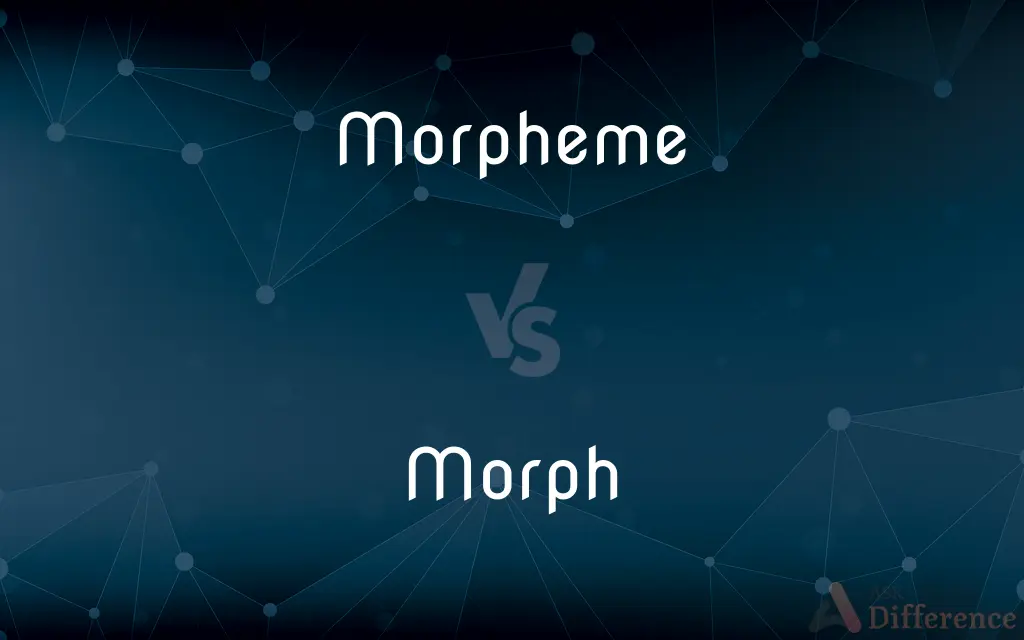Morpheme vs. Morph — What's the Difference?
By Urooj Arif & Fiza Rafique — Updated on March 29, 2024
A morpheme is the smallest grammatical unit in a language that carries meaning, whereas a morph is a variation in the form of a word to express different grammatical categories.

Difference Between Morpheme and Morph
Table of Contents
ADVERTISEMENT
Key Differences
Morphemes are the foundational elements of language, composed of individual units of meaning that cannot be further divided without losing or altering their meaning. In contrast, a morph, short for "morphological form," refers to the physical form a word takes to convey different grammatical or syntactical information within a given context.
Morphemes are categorized into two main types: free morphemes, which can stand alone as words (e.g., "book," "cycle"), and bound morphemes, which cannot stand alone and must be attached to other morphemes (e.g., "-s" for plurals, "-ed" for past tense). Morphs, however, are more concerned with the application and variation of these morphemes in practice, demonstrating how the base or root words are adapted to fit into grammatical structures.
The study of morphemes falls under the broader linguistic field of morphology, which deals with the structure of words and their constituent parts, including how they are formed and their relationship to other words in the language. The concept of a morph is also integral to morphology, focusing on how the forms of words change and adapt in different linguistic contexts to express nuanced meanings or grammatical functions.
Understanding the distinction between morphemes and morphs is crucial for linguistics, as it sheds light on the mechanics of language formation, evolution, and usage. While morphemes are about the inherent meaning contained within the parts of words, morphs deal with the practical, often visible changes that words undergo to fit into communicative contexts, highlighting the dynamic nature of language.
In essence, while both morphemes and morphs are vital to the study of linguistics, they focus on different aspects of words: morphemes on the immutable units of meaning, and morphs on the adaptable forms those units take to express varied grammatical or syntactical nuances.
ADVERTISEMENT
Comparison Chart
Definition
The smallest grammatical unit that carries meaning.
A variation in the form of a word to express grammatical categories.
Types
Free (can stand alone) and bound (must be attached).
Not typically categorized, but varies by tense, number, case, etc.
Function
Conveys basic units of meaning within a language.
Demonstrates variations of words for grammatical conformity.
Example
"Quick" (a free morpheme), "-ly" (a bound morpheme).
"Quickly" comprises the morphs "quick" and "-ly" to indicate manner.
Study
Focuses on the inherent meaning and structure of words.
Focuses on the practical application and variation in form.
Linguistic Role
Fundamental in building words and conveying meaning.
Essential in adapting words to fit grammatical and syntactical contexts.
Compare with Definitions
Morpheme
Essential for constructing words.
Un- + happy + -ness = unhappiness.
Morph
A variation of a word.
Writes, wrote, and written are morphs of write.
Morpheme
A unit of meaning in a language.
Re- in redo means again.
Morph
Used to fit into sentence structures.
He is running uses the running morph.
Morpheme
Can be a standalone word or a part of a word.
Book is a morpheme by itself.
Morph
Demonstrates word form changes.
Child to children shows a morphological change.
Morpheme
Forms the foundation of linguistic study.
The study of morphemes reveals how words carry meaning.
Morph
Reflects grammatical changes.
Adding -s for plural forms.
Morpheme
Includes prefixes, suffixes, and infixes.
-ing in running.
Morph
Shows linguistic flexibility.
Go becomes goes, going, gone, showcasing different morphs.
Morpheme
A morpheme is the smallest meaningful lexical item in a language. A morpheme is not necessarily the same as a word.
Morph
An allomorph.
Morpheme
A meaningful linguistic unit that cannot be divided into smaller meaningful parts. The word man and the suffix -ed (as in walked) are morphemes.
Morph
One of various distinct forms of a species (such as color variant) or of an organism during different parts of its life cycle.
Morpheme
(linguistic morphology) The smallest linguistic unit within a word that can carry a meaning.
Morph
To transform (an image) by computer
Cinematic special effects that morphed the villain into a snake.
Morpheme
The smallest unit of meaning of a language, which cannot be divided into smaller parts carrying meaning; it is usually smaller than a single wordform, such as the -ed morpheme of verbs in the past tense or the -s morpheme of nouns in the plural form.
Morph
To be transformed
"By morning all his hurt feelings had morphed into mischief" (Dana Adam Shapiro).
Morpheme
Minimal meaningful language unit; it cannot be divided into smaller meaningful units
Morph
A recurrent distinctive sound or sequence of sounds representing an indivisible morphological form; especially as representing a morpheme.
Morph
(linguistics) An allomorph: one of a set of realizations that a morpheme can have in different contexts.
Morph
(zoology) A variety of a species, distinguishable from other individuals of the species by morphology or behaviour.
Morph
A computer-generated gradual change from one image to another.
Morph
(slang) morphine
Morph
To change shape, from one form to another, through computer animation.
Morph
To shapeshift.
Morph
(by extension) To undergo dramatic change in a seamless and barely noticeable fashion.
Morph
A sequence of phonemes, often a word fragment, which constitutes the minimum unit of meaning or syntax within a given word. A morph may be one of several variants of a morpheme, depending for its individal form on the context in which it occurs. Thus the morphs -s and -es are variants of the morpheme by which the plural form of an English noun is expressed.
Morph
To transform smoothly in imperceptible steps from one image to another, on a computer screen.
Morph
Cause to change shape in a computer animation;
The computer programmer morphed the image
Morph
Change shape as via computer animation;
In the video, Michael Jackson morphed into a panther
Common Curiosities
What is the difference between a morpheme and a morph?
A morpheme is the smallest unit of meaning, while a morph is the form that a word takes to express different grammatical categories.
Is a morph the same as a word?
Not exactly. A morph can be a word, but it refers specifically to variations of a word that reflect grammatical categories.
How do morphemes contribute to language?
Morphemes build words and convey fundamental meanings, serving as the building blocks of language.
Are all morphemes visible in speech?
In speech, morphemes are represented by their phonological counterparts, but some morphological processes might not be explicitly pronounced.
Can a word have multiple morphemes?
Yes, words can be composed of multiple morphemes, each adding to or altering the base meaning.
What role do bound morphemes play in language?
Bound morphemes modify the meanings of root words and cannot stand alone, playing a critical role in the formation of complex words.
What is an example of a free morpheme?
"Book" is a free morpheme because it can stand alone and carries meaning by itself.
How does a morph differ from a morpheme in practical usage?
A morph represents a word's form in actual use, varying to express tense, number, etc., while a morpheme is a theoretical concept of meaning.
Can the concept of morphs apply to all languages?
Yes, the concept of morphs applies universally, though the specifics of how morphological changes are realized can vary greatly among languages.
Why is the study of morphs important in linguistics?
Studying morphs helps understand how words adapt in form to express grammatical nuances, reflecting the dynamic nature of language.
How do morphemes and morphs interact in language?
Morphemes provide the basic units of meaning, and morphs are the variations of these units as they are used in grammatical contexts.
Share Your Discovery

Previous Comparison
Plan vs. Arrangement
Next Comparison
Dumb vs. DumAuthor Spotlight
Written by
Urooj ArifUrooj is a skilled content writer at Ask Difference, known for her exceptional ability to simplify complex topics into engaging and informative content. With a passion for research and a flair for clear, concise writing, she consistently delivers articles that resonate with our diverse audience.
Co-written by
Fiza RafiqueFiza Rafique is a skilled content writer at AskDifference.com, where she meticulously refines and enhances written pieces. Drawing from her vast editorial expertise, Fiza ensures clarity, accuracy, and precision in every article. Passionate about language, she continually seeks to elevate the quality of content for readers worldwide.















































